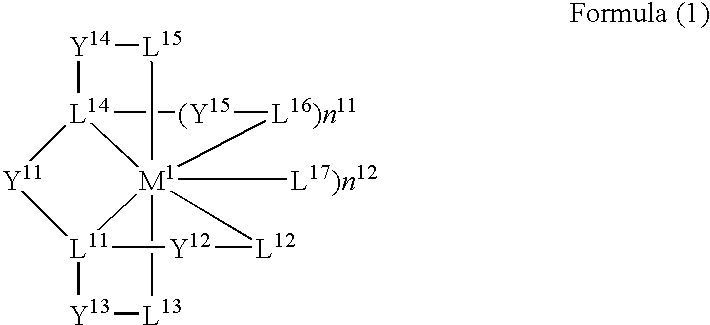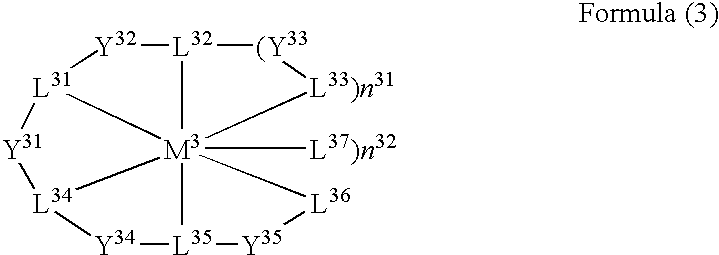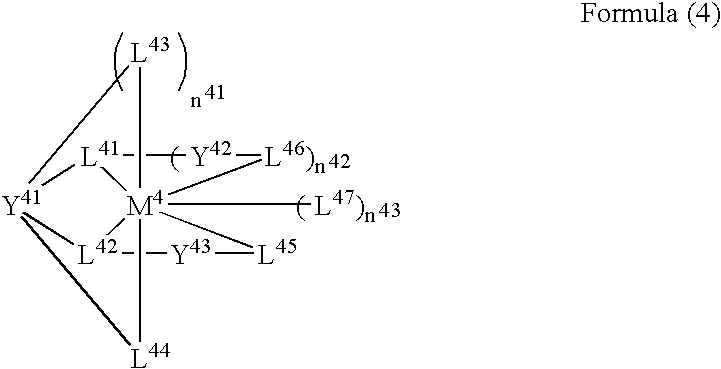Organic electroluminescent device
an electroluminescent device and organic technology, applied in the field of organic electroluminescent devices, can solve the problems of low quantum efficiency of devices, need of further improvement, and devices having phosphorescent materials that are unsatisfactory in durability
- Summary
- Abstract
- Description
- Claims
- Application Information
AI Technical Summary
Benefits of technology
Problems solved by technology
Method used
Image
Examples
example 1
[0197] A luminescent device is manufactured in the same manner as in Comparative Example 1 except that Ir(ppy)3 in the luminescent layer in Comparative Example 1 is altered to the complex K-9 of the invention and evaluated in the same method as in Comparative Example 1.
[0198] Green light emission (526 nm) is observed and the external quantum efficiency (η1000) at a luminance of 1,000 cd / m2 is 12%. The device is allowed to emit light successively at an initial luminance of 1,000 cd / m2 to find the time (half-value period of luminance) required for the initial luminance to be decreased to 500 cd / M2 and as a result, the time is found to be about 180 hours.
example 2
[0199] A luminescent device is manufactured in the same manner as in Comparative Example 1 except that Ir(Ppy)3 in the luminescent layer in Comparative Example 1 is altered to the complex K-19 of the invention and evaluated in the same method as in Comparative Example 1.
[0200] Blue light emission is observed and the external quantum efficiency (η1000) at a luminance of 1,000 cd / m2 is 7%. The device is allowed to emit light successively at an initial luminance of 1,000 cd / m2 to find the time (half-value period of luminance) required for the initial luminance to be decreased to 500 cd / m2 and as a result, the time is found to be about 170 hours.
example 3
[0201] A luminescent device is manufactured in the same manner as in Comparative Example 1 except that Ir(ppy)3 in the luminescent layer in Comparative Example 1 is altered to the complex K-43 of the invention and evaluated in the same method as in Comparative Example 1.
[0202] Blue light emission is observed and the external quantum efficiency (η1000) at a luminance of 1,000 cd / m2 is 5%. The device is allowed to emit light successively at an initial luminance of 1,000 cd / m2 to find the time (half-value period of luminance) required for the initial luminance to be decreased to 500 cd / M2 and as a result, the time is found to be about 200 hours.
PUM
| Property | Measurement | Unit |
|---|---|---|
| maximum wavelength | aaaaa | aaaaa |
| wavelength | aaaaa | aaaaa |
| temperature | aaaaa | aaaaa |
Abstract
Description
Claims
Application Information
 Login to View More
Login to View More - R&D
- Intellectual Property
- Life Sciences
- Materials
- Tech Scout
- Unparalleled Data Quality
- Higher Quality Content
- 60% Fewer Hallucinations
Browse by: Latest US Patents, China's latest patents, Technical Efficacy Thesaurus, Application Domain, Technology Topic, Popular Technical Reports.
© 2025 PatSnap. All rights reserved.Legal|Privacy policy|Modern Slavery Act Transparency Statement|Sitemap|About US| Contact US: help@patsnap.com



